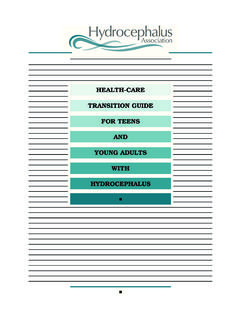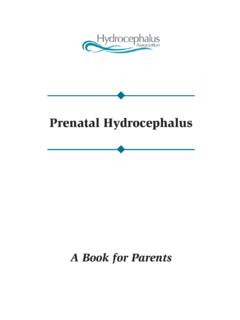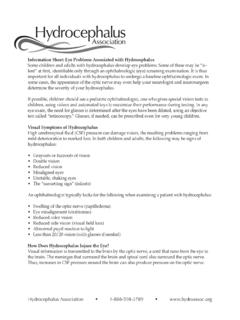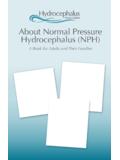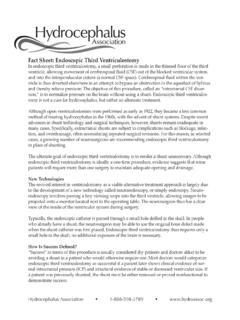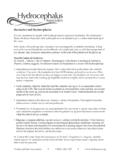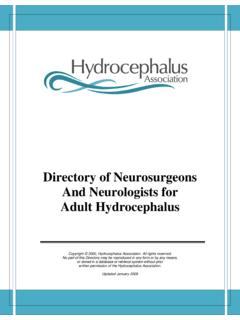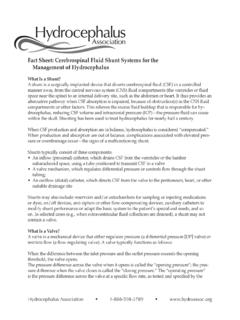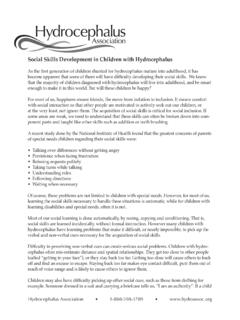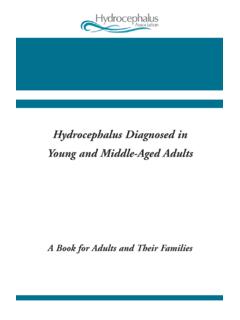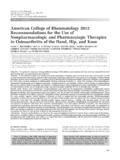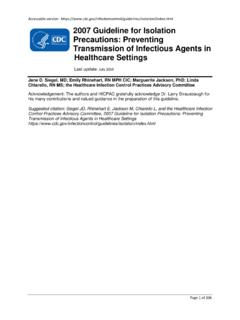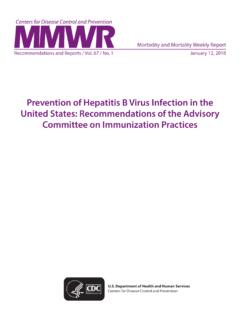Transcription of A TEACHER’S GUIDE TO HYDROCEPHALUS
1 ATEACHER SGUIDETOHYDROCEPHALUSnnForeword.. 3 Introduction.. 51:What Is HYDROCEPHALUS ?.. 7 What Causes HYDROCEPHALUS ? ..7 How Is It Treated? ..7 What Are the Effects of HYDROCEPHALUS ? ..8 Conclusion ..82: Physical Problems Associated with HYDROCEPHALUS .. 9 Shunt Problems ..9 Precocious Puberty ..10 Headaches ..10 Seizures ..10 Hand/Eye Coordination ..103: Learning Disabilities.. 11 Nonverbal Learning Disorder ..12 Motor Skills ..12 Organizational ..14 Attention ..14 Verbal Abilities ..14 Strategies ..144: Social and Emotional Issues.
2 17 Social Issues ..18 Strategies ..195: Moving Forward, Making a Difference:Additional Resources and Strategies.. Room teacher /Resource Specialist ..21 Students ..22 Other Resources ..22 Conclusion ..22 AppendixA: About IEPs ..23B: Consensus Statement on Physical Activitiesfor Children with : Signs and Symptoms of Shunt Malfunction ..25D:Additional Resources ..26 ContentsAcknowledgmentsWe extend a heartfelt thank you to all the parents, teachers, doctorsand education professionals who reviewed a draft of this bookletand/or answered our questions.
3 Special thanks to Cindy Bader, DebbyBuffa, Jana Dransfield, Kathy Farmer, Joseph Feldman (CASE), PaulaFrench, Jennifer and Eric Henerlau, Amy Herrington, Catherine LyethReddy, Chris Riccio, and Thomas Sullivan, booklet was made possible by funds contributed by the Cali-fornia Casualty : Rachel FudgeAssistant Editor: Pip MarksThe following references were consulted in the preparation of thisbooklet:About HYDROCEPHALUS A Book for Families, HYDROCEPHALUS Association HYDROCEPHALUS , by J. M. Fletcher, et al., in K.
4 , et al.,Pedi-atric Neuropsychology: Research, Theory, and Practice(NewYork: Guilford Press, 1999)National Information Center for Children and Youth with Disabilities, Learning Disorders on the Web, Nonverbal Learning Disorders, by Sue Thompson, , LD Online, Nonverbal Learning Disorder Syndrome, Fact Sheet, HydrocephalusAssociation Social Skills Development in Children with HYDROCEPHALUS , FactSheet, HYDROCEPHALUS AssociationSpecial Education Rights and Responsibilities,Community Alliancefor Special Education (CASE) and Protection and Advocacy, Inc.
5 (PAI)Students with Spina Bifida and/or HYDROCEPHALUS : A GUIDE forEducators, Spina Bifida and HYDROCEPHALUS Association of Canada 2002 HYDROCEPHALUS Association, San Francisco, CaliforniaHydrocephalus Association870 Market Street, Suite 705 San Francisco, CA 94102 Tel 415-732-7040 Fax booklet about HYDROCEPHALUS is written for teachers inthe hope that the information will give you a better under-standing of this lifelong condition and how it can affect a stu-dent s ability to learn and mature intellectually, socially a teacher .
6 You are not just an educator you are a rolemodel, a mentor and a GUIDE . Having a student with hydro-cephalus in your class can be a challenge, but it also presents aspecial opportunity. Most children with HYDROCEPHALUS havenormal or above-average intelligence and are eager and willingto learn and succeed. It is not uncommon, however, for themto have learning disabilities that have the potential to hindertheir overall development if not recognized and remediated ina timely affects about one in every 500 to 1,000 chil-dren born.
7 It is caused by a wide variety of medical problems,and the circumstances of each child s condition are is no standard profile of the child with HYDROCEPHALUS just as there is no standard profile of the typical child. We will discuss some of the common challenges faced bymany children with HYDROCEPHALUS , but it is important toremember that some children will face more serious chal-lenges, while others will have far fewer problems. A discussionof more severely affected children and their special-educationneeds is beyond the scope of this booklet, which primarily dis-cusses the needs and challenges of children in hope that this booklet will give you a better insight intohow HYDROCEPHALUS can affect a child s learning style andsocial and emotional growth; provide you with strategies torecognize and help remediate areas of weakness and vulnera-bility.
8 And empower you to challenge all of your students, espe-cially those with special needs, to fulfill their is sometimes referred to as an invisible disabil-ity meaning that the disability is not immediately visuallyapparent. Many people with HYDROCEPHALUS look normal. Underneath a seemingly typical exterior, however, there lies ahost of potential physical, emotional and intellectual most common of these are learning disabilities, poorlydeveloped social skills and some degree of loss of fine or grossmotor children with HYDROCEPHALUS have undergone traumat-ic experiences, often at a very young age: multiple surgeries,frequent hospital stays, lengthy rehabilitation and countlessdoctor visits and medical tests.
9 Starting school for the first timeor returning to school after a hospital stay can be an extrachallenge. It can be scary not just for the child with hydro-cephalus but also for his or her peers, who often do not knowhow to express their own fears and in turn canresult in peer rejection, loneliness and with HYDROCEPHALUS are often characterized asbright and highly often have a lot to say and arefriendly toward their yet this very sociability andintelligence can mask some deeper theymay be very verbal.
10 Their conversation may have little depth orlack may befriend adults and childrenyounger than they are. Often, they do not possess the samenuanced social skills as their parents and teachers may be blinded by displays ofverbal intelligence, especially in the younger grades, not realiz-ing that learning disabilities often do not become apparentuntil later on, in the middle grades. Sometimes, what appear tobe behavioral issues can be manifestations of learning disabili-ties. A student who appears to be not applying him- or herself,or simply not trying, may in fact be struggling very hard tokeep it s not simply a matter of working harder orstudying more: it s a matter of learning howto work and studyin order to learn and retain knowledge and with HYDROCEPHALUS are always at risk of recurring medical problems, new or changing learning dis-abilities, and social and emotional issues.
